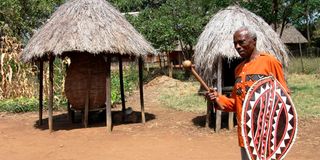Thingira, a cultural getaway

David Manyeki, a guide, showing some of the weapons at the Thingira Cultural Centre in Sagana.
A friend sent me a newspaper article about the Thingira Cultural Centre in Sagana. The article said that the mission of the centre was ‘to revive and preserve Kikuyu customs’. I was intrigued. So I checked it was still operational and, last Monday, I went there with one of our staff, Peter Kamau, as driver and guide.
The centre is off the Nairobi to Nyeri Road and about 400 metres beyond the bridge over the Tana River. After the very cold spell, the sun was shining, and it was an easy drive now that there is dual-carriageway right to the bridge. The turning to the centre is a sandy track on the left of the road, marked by a big sign.
The centre’s main feature is a reconstruction of a Kikuyu homestead – the various small huts with mud and wattle walls and thatched roofs. We had an excellent guide in David Manyeki, a mzee with a fund of knowledge about traditional customs and practices – and a relish for conversations about what he was telling and showing us.
David started by taking us to the house, the nyumba, of the senior wife. He amused us by calling her the ‘starter wife’. He pointed out the various sections of the nyumba: the bed space, store for food, stores for implements and utensils, goats area and a special space for fattening goats before slaughter. The number of such nyumba depended on the number of wives the man had, because, as David explained, no two wives could share a nyumba. But the unmarried daughters shared the nyumba of their respective mothers or grandmothers.
We moved to the man’s, the head of the homestead’s thingira, which was set apart and near the entrance of the compound. The example of a son’s huts was much smaller. Inside, we found a number of weapons: bows and arrows, a shield and various clubs or njuguma. It triggered David to talk about traditional and recurring conflicts – not only with the Masai but also with neighbouring clans.
Outside, in the open and well-swept area called the nja, Wanjiru and Wambui demonstrated some less hostile things – how cooking was done on the three stones fireplace and the way grains were pounded into flour. Then we walked to the kitchen garden to see a range of crops that would have been grown in a Kikuyu homestead. There were bananas, yams, millet and sweet potatoes – some of the first crops grown by the Kikuyu. There were also later additions such as cassava, maize and various beans and peas. This stimulated talk about staple foods such as githeri (the mixture of boiled maize and beans) and mukimo (the mash of potatoes, beans or peas and pumpkin leaves).
Visitors to the centre can be served such Kikuyu dishes, as well as a special soup and even the traditional brew of muratina, the sweet homemade wine, made from fruit of the sausage tree and honey or uki. David, with three sizes of cow horn, showed us how muratina was served and drunk by the elders – always making sure to spit some to the ground in honour of their ancestors. We could have stayed all day, discussing the changes that have occurred in attitudes and behaviours – in relation to gender issues, governance structures – in the home and in communities. But Peter and I had to be on our way.
There are a number of activities at the centre that can be enjoyed by visitors, including guided walks along the Tana River, which is close by. There is accommodation, too. But the centre is still in its recovery mode, having suffered during the Covid time. If you want to make a casual visit, have an overnight stay, or engage in one of the activities, make a booking and check on prices by ringing Leah at 0735 889350.
John Fox is Chairman of iDC Email: [email protected]





